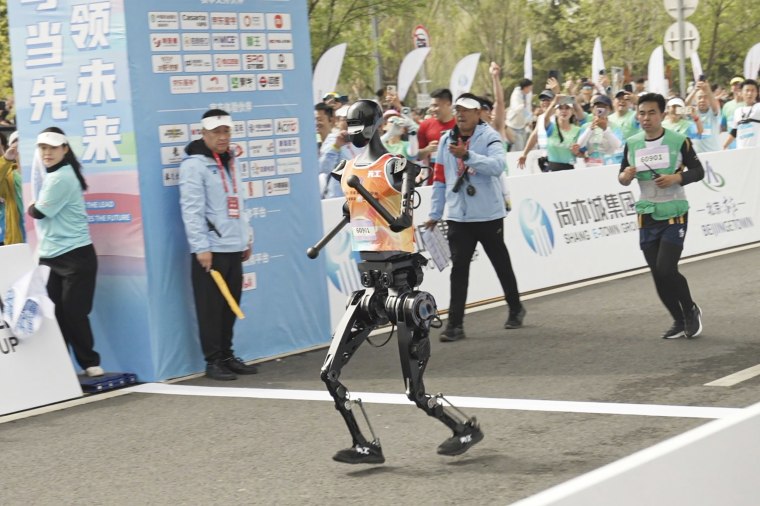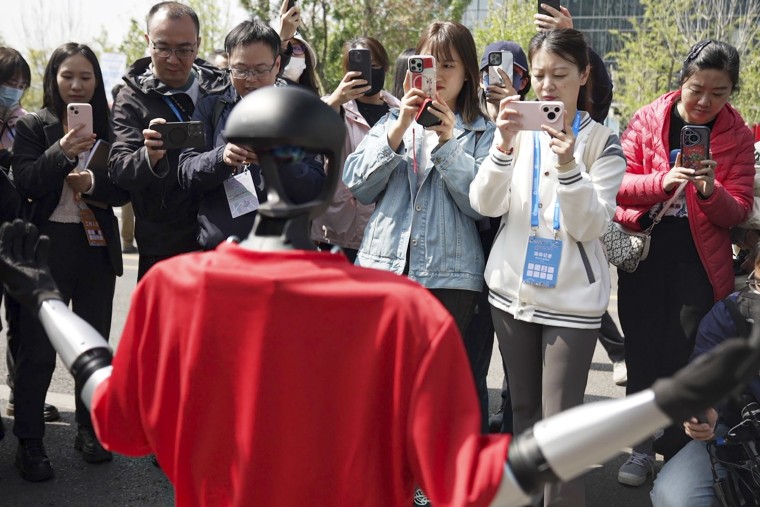BEIJING — In the global race to produce robots that are smarter and faster, China’s humanoids have come a long way. Robots from cutting-edge Chinese companies can dance and spin or do roundhouse kicks, as they have demonstrated in videos that are all over China’s internet.
Yet when humanoids and robots were invited to join real flesh-and-blood runners for a half-marathon in Beijing this past weekend, the race garnered attention but also laid bare the challenges still facing the industry as China seeks to dominate technologies of the future.
Some of the robots barely got started. One, designed with a woman’s body and face, collapsed moments after getting started, sending a group of engineers rushing to its side with laptops. Another that was mounted to a platform with propellers crashed into a barrier.
A robot the size of a young child succumbed to a glitch and simply lay down on the starting line.

Hailed as a “historic moment” by the Chinese government, the race came amid an intensifying tech rivalry between the U.S. and China, the world’s two biggest powers in artificial intelligence. While China remains a distant second, it leads the world in AI publications and patents and is closing the gapin terms of the quality of AI models. U.S. investors were spooked early this year when the Chinese start-up DeepSeek released a ChatGPT-like model developed at a fraction of the cost.
Much as it has with electric vehicles, the Chinese government has been promoting humanoid robots as a potential engine of economic growth, even as the Trump administration tightens U.S. export controls on AI chips on which Chinese developers rely. Several Chinese state-backed industry groups have declared that U.S.-made chips are “no longer safe or reliable.”
The robot-human race was another step forward in China’s goal of becoming the world leader in humanoid robots by 2027.
“That more than 20 robot companies participated shows that robot tech in China is pushing forward quickly,” said Guo Yijie, team lead for the winning robot, Tiangong Ultra, which was developed by the Beijing Innovation Center of Humanoid Robotics.
As the starting siren echoed through the air, the first batch of robots jogged ahead, their metal legs thumping loudly against the track. The tallest robot was 5 feet, 10 inches, while the shortest, nicknamed “Little Giant,” measured less than 2½ feet and drew cheers from the crowd as it swaggered past and waved enthusiastically.
Some robots ran smoothly like humans while others had stiffer, more mechanical movements. Each also had a unique style: Some had lifelike skin and hair, others wore clothes, and a few ran in sneakers.
Companies developing humanoid robots in China, the U.S. and elsewhere hope they might eventually be able to do jobs ranging from manufacturing to caregiving.
“Our vision is for humanoid robots to integrate into various industries and households, serving humanity in meaningful ways,” said Wei Jiaxing, brand and public relations lead at the Beijing Innovation Center of Humanoid Robotics. “They can enhance productivity, improve efficiency and help address labor shortages.”
When it came to running, however, the robots were no match for the human contestants, who had time to stop and snap selfies with them along the 13-mile course in Yizhuang, a tech hub district in southeast Beijing.
Midway through the race, some robots became too “tired” to continue on their own, and their human operators had to guide them with leashes. The robots were allowed to swap batteries or even be replaced by another machine altogether.

Of the 21 robots, six made it to the finish line. The winning robot, Tiangong Ultra, completed the race in 2 hours and 40 minutes, after three battery changes and one fall. That compares with 1 hour and 2 minutes for the human winner of the men’s race. Li Qingdu, founder of the Shanghai-based manufacturer DroidUp, said he was not concerned with the race’s rankings. His humanoid robot came in third at 4 hours and 25 minutes.
“What matters most to us is testing things — for example, whether the robot can finish the whole race without changing batteries,” Li said.
Battery life has been a longtime challenge for robotics companies. China dominates the battery industry, holding a 70% to 90% share of the global market at every stage of the value chain for lithium ion batteries, according to the Carnegie Endowment for International Peace, a Washington-based think tank.
China also dominates the production and processing of rare earth elements, which are crucial for making robots. On Tuesday, Tesla CEO Elon Musk said production of its Optimus humanoid robots had been disrupted by export curbs on rare-earth magnets that China recently imposed in response to U.S. tariffs.
Despite their stumbles in the race, the robot runners stoked national pride. Spectators on site cheered on the robots while millions of viewers tuned in via livestream, hyping up the public discourse on the country’s tech progress.
Race participant Zou Dewen said it was “exciting and unique” for him to run alongside humanoid robots.
“This humanoid robot marathon is the first of its kind, and it’s happening here in China, in Beijing,” Zou said. “I think it’s something we can be really proud of.”
Janis Mackey Frayer and Dawn Liu reported from Beijing and Peter Guo from Hong Kong.

